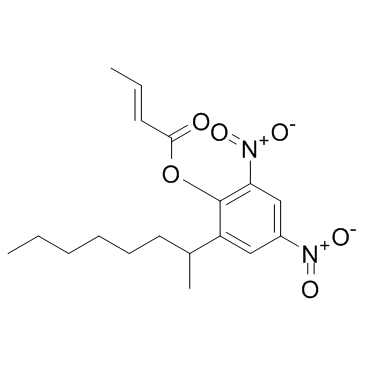Meptyldinocap (also known as 2,4-DNOPC) is a novel and potent powdery mildew (Erysiphe necator) fungicide which shows protectant and post-infective activities.
Physicochemical Properties
| Molecular Formula | C18H24N2O6 |
| Molecular Weight | 364.4 |
| Exact Mass | 364.163 |
| CAS # | 131-72-6 |
| PubChem CID | 5284389 |
| Appearance | Typically exists as solid at room temperature |
| Density | 1.175 g/cm3 |
| Boiling Point | 473.7ºC at 760 mmHg |
| Flash Point | 173.9ºC |
| Vapour Pressure | 3.85E-09mmHg at 25°C |
| Index of Refraction | 1.54 |
| LogP | 6.104 |
| Hydrogen Bond Donor Count | 0 |
| Hydrogen Bond Acceptor Count | 6 |
| Rotatable Bond Count | 9 |
| Heavy Atom Count | 26 |
| Complexity | 511 |
| Defined Atom Stereocenter Count | 0 |
| SMILES | C/C=C/C(OC1=C([N+]([O-])=O)C=C([N+]([O-])=O)C=C1C(C)CCCCCC)=O |
| InChi Key | NIOPZPCMRQGZCE-WEVVVXLNSA-N |
| InChi Code | InChI=1S/C18H24N2O6/c1-4-6-7-8-10-13(3)15-11-14(19(22)23)12-16(20(24)25)18(15)26-17(21)9-5-2/h5,9,11-13H,4,6-8,10H2,1-3H3/b9-5+ |
| Chemical Name | (2,4-dinitro-6-octan-2-ylphenyl) (E)-but-2-enoate |
| HS Tariff Code | 2934.99.9001 |
| Storage |
Powder-20°C 3 years 4°C 2 years In solvent -80°C 6 months -20°C 1 month |
| Shipping Condition | Room temperature (This product is stable at ambient temperature for a few days during ordinary shipping and time spent in Customs) |
Biological Activity
| References |
[1]. Analytical method for the determination of meptyldinocap as the 2,4-dinitro-octylphenol metabolite in cucumber and soil using LC-MS/MS and a study of the residues in a Chinese cucumber field ecosystem. Pest Manag Sci. 2014 Jan;70(1):97-102 |
| Additional Infomation |
Dinocap can cause developmental toxicity according to state or federal government labeling requirements. 2,4-dinitro-6-(octan-2-yl)phenyl (E)-but-2-enoate is an enoate ester obtained by formal condensation of the carboxy group of 3-methylacrylic acid with the phenolic hydroxy group of 2,4-dinitro-6-(octan-2-yl)phenol. It is a C-nitro compound and an enoate ester. |
Solubility Data
| Solubility (In Vitro) |
DMSO : ≥ 150 mg/mL (~411.65 mM) Ethanol : ~100 mg/mL (~274.43 mM) |
| Solubility (In Vivo) |
Solubility in Formulation 1: ≥ 2.5 mg/mL (6.86 mM) (saturation unknown) in 10% DMSO + 40% PEG300 + 5% Tween80 + 45% Saline (add these co-solvents sequentially from left to right, and one by one), clear solution. For example, if 1 mL of working solution is to be prepared, you can add 100 μL of 25.0 mg/mL clear DMSO stock solution to 400 μL PEG300 and mix evenly; then add 50 μL Tween-80 to the above solution and mix evenly; then add 450 μL normal saline to adjust the volume to 1 mL. Preparation of saline: Dissolve 0.9 g of sodium chloride in 100 mL ddH₂ O to obtain a clear solution. Solubility in Formulation 2: 2.5 mg/mL (6.86 mM) in 10% DMSO + 90% (20% SBE-β-CD in Saline) (add these co-solvents sequentially from left to right, and one by one), suspension solution; with ultrasonication. For example, if 1 mL of working solution is to be prepared, you can add 100 μL of 25.0 mg/mL clear DMSO stock solution to 900 μL of 20% SBE-β-CD physiological saline solution and mix evenly. Preparation of 20% SBE-β-CD in Saline (4°C,1 week): Dissolve 2 g SBE-β-CD in 10 mL saline to obtain a clear solution. (Please use freshly prepared in vivo formulations for optimal results.) |
| Preparing Stock Solutions | 1 mg | 5 mg | 10 mg | |
| 1 mM | 2.7442 mL | 13.7212 mL | 27.4424 mL | |
| 5 mM | 0.5488 mL | 2.7442 mL | 5.4885 mL | |
| 10 mM | 0.2744 mL | 1.3721 mL | 2.7442 mL |
